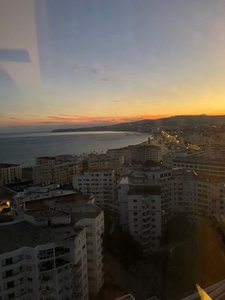Advertisement
Published: October 28th 2023

 Hilton Tanger City Center
Hilton Tanger City Center
Sunrise from La Kasbah RestaurantWe had an early departure from Tangier, since it was going to be a long day of traveling South on our way to Fes. But the early departure gave us an opportunity to observe the beautiful sunrise from the 15th Floor La Kasbah Restaurant at the hotel, the Hilton Tanger City Center.
In addition, one of the highlights of the trip was scheduled for that day, the anticipated tour of Chefchaouen, The Blue Pearl, nestled in the Rif Mountains. The early departure meant more time spent exploring this gem. We carefully packed the pastries we had bought the night before so that we didn't have to waste the precious time in the city waiting to be served lunch. Apparently, waiting for a meal can be a lengthy process in Chefchaouen.
The name Chefchaouen means "look at the horns," referring to the two mountain peaks that form a background to the city. It was founded in 1471 as a small kasbah to defend against the Portuguese invasions of northern Morocco, and many Moriscos and Spanish Jews settled there after fleeing from Spain.
The drive into the mountains provided many beautiful views of valleys covered in mist and dotted with

 Drive to Chefchaouen
Drive to Chefchaouen
A convenience stop during the drive. small villages, and at a convenience stop the view of a lake formed by the creation of a dam was awe inspiring.
I do not know if the abundance of various shades of blues eventually becomes boring to the residents, but for a visitor like me it was beautiful and inspiring.
I do believe that Chefchaouen was the one place where I took the most photos. I just couldn't get enough. At every corner there was a new, delightful sight.
We again entered the city through one of the upper gates and made our way down through the colorful alleys until we arrived at the main square. Then we were given some time to explore on our own, and soon found ourselves in the hands of an enterprising shop keeper who made sure that we made all our purchases through him and his relatives.
It was here that I made my first unplanned purchase. I was told I would be helping five families who lived in the mountains and made the throws by hand. OK, I'll bite. It was a throw for my sofa in the blue tones of the city that goes perfectly with the
existing pillows and has become a beautiful addition to my living room.
A delightful experience was a stop at a small fruit juice stand in an inconspicuous corner just outside the entrance to a hostel off the main square. The cheerfully decorated stand beckoned as a shady spot for a rest and a cold glass of freshly made Pomegranate juice, and once the owner found out that I spoke Spanish, he proceeded to tell me the long history of the relationship between Spain and Chefchaouen. I must admit that it felt good to be able to communicate with a local. In Morocco, students learn Arabic and French in school, so it's not that common for them to also know English. It didn't take long for us to get the strong suspicion that in many cases the person addressed would smile and nod as the path of least resistance but had really not understood a word that had been said. We knew that Spanish was a common third language in some areas, but this was our only time encountering it.
But we were told that recently English has been added to the curriculum after a certain grade, so it
should be more common in the future. One exception to the language is the Sub-Saharan immigrants that are flooding into Morocco as a steppingstone to crossing into Europe. The illegal immigration is a big problem, and most of these unfortunate individuals just get stuck in Morocco trying to eek a living somehow. Of course, they are more prominent in the coastal cities. Apparently, a common method of trying to cross is by the use of jet skis, and hundreds are intercepted on a regular basis.
Alas, much too soon we had to make our way out of beautiful Chefchaouen to continue our trip to Fes. However, once we stopped at a lookout to survey the two Medinas of Fes, we immediately started anticipating what awaited us.
Shortly after we arrived at one of the last points that vehicles could access where we were met by the porters with carts to transport our luggage to our hotel, The Riad al Yacout, inside the 8th century Medina!
Three buildings had been converted into a hotel, and we were staying at the main building overlooking the main courtyard that served as our dining room. A beautiful setting, although I felt
terribly sorry for the porter that had to carry our suitcases up that challenging staircase. I had my own difficulties with it, even empty handed.
Advertisement
Tot: 0.048s; Tpl: 0.013s; cc: 10; qc: 28; dbt: 0.0264s; 1; m:domysql w:travelblog (10.17.0.13); sld: 1;
; mem: 1.1mb























